When we come upon a spring bubbling out from beneath a tree on a wooded hillside it can seem magical–water emerging from inside the earth. Springs are a type of wetlands. Are wetlands sacred? On World Wetlands Day, February 2, we are invited to become aware of the immense ecological value of wetlands. Holy wells and sacred springs are wetlands. Many are sacred to St.Brigid, whose feast day of Imbolc is February 1. Imbolc is the Irish festival to welcome Spring back to the land.
The world-wide loss of over half of wetlands, those wet and fecund habitats, which nourish astounding amounts of biological diversity, is a major reason for the extinction crisis we face. Thankfully, concerned scientists study the needs of wetland plants, animals, and waters, but they so often leave out the intertwined relationship of people and nature, as if we are separate. A basic human need, at least before we were conditioned out of it, is to be creators amidst Creation, lovers amidst a great Love, givers of gratitude to the ever-giving EarthSpirit. The impulse to participate in the universe in our role as conscious beings has given rise to many forms of indigenous spirituality unique to the qualities of the various living environments. In Ireland, with its characteristically wet climate, springs are abundant, and water is honored in the form of thousands of holy wells.
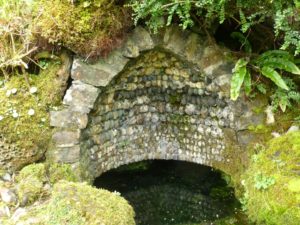
Are wetlands holy? Conservationists are being called to recognize that many peoples the world over regard wetlands as spiritually significant, and, importantly, those wetlands that are regarded as sacred are more likely to be conserved. Science must rejoin spirituality if we are to have any hope of saving life on earth as we know it. Indigenous ecological knowledge is always a sacred knowing. In America our indigenous water defenders are fighting—in a way that fully includes their spiritual understandings and practices—for the life of rivers and wetlands. Indeed, they are rising up forcefully to remind us that water is sacred, that “water is life.” The Celtic people have always honored fresh waters as healing. When we bless and protect water, it blesses and heals us, physically, emotionally, and spiritually.
I grew up on an island in the ocean and, even as a child, had a strong feeling that the ocean and its lapping shore was imbued with and emanated some indescribable divine presence.
But, in my whole ordinary American life I was never taught that water was sacred. I knew one could be blessed as a Protestant Christian at a baptismal font, but the water was just the carrier of sanctity, not itself sacred. When we began going to Ireland and visited a holy well for the first time, it was as if my life had circled around, at last, to a people with a shared recognition of water as sacred. After that, every return trip became a pilgrimage to a spiritual homeland where kindred spirits recognized fresh waters as sacred. On each visit I was drawn, as if insatiably, to visit as many holy wells as we could find. There are some 3,000 holy wells in Ireland. We’ve sought out maybe a hundred of them. Quite a few we’ve come upon by accident, driving by and suddenly spotting a sign for a lovingly tended countryside well. St. Kieran’s was a little niche beside the road to Slieve League with an unforgettable statue of and an amazing list of prayers to perform for the ‘rounds.’

Holy wells come in as many different forms as the emerging water itself. Many holy wells are rock-enclosed upwellings of water from underground streams. Some may emerge from the side of mountains. Most are clear springs at which water bubbles gently and continuously to the surface. And some boil up powerfully, creating forceful, cold flows in which to courageously immerse feet—or more.
Water rising to the surface forms wetlands. Wetlands are liminal places halfway between water and land. Archetypally, human consciousness recognizes liminal places, whether above on a mountain—halfway between earth and sky—or below in wetlands as places where soul can go to experience the otherworld, that reality which is halfway between earthworld and spiritworld. Liminal places, like wetlands, being neither this nor that, neither fully wet nor fully dry, are places where fixed categories are interrupted, so the mind can more easily enter its own halfway point—soul—on the way to spirit. The Irish call these “thin places.”
Many liminal places the world over are places of pilgrimage. In pilgrimage body joins soul in its quest for spirit. Body is soul’s partner in the urge to experience spirit. Rumi says “There is some kiss we want with our whole lives—the touch of spirit on the body.” In pilgrimage, the body is challenged to exert effort in order to serve the soul’s desire to worship at spirit-imbued sites like holy wells. The commitment of energy lets the spirits know that the intention is serious. The effort is purifying and prepares us to arrive at a place of prayer. Some holy wells require climbing high into misty mountain passes like Mam Ean, the Pass of the Birds, in Connemara. We hiked up to the lovely, lonely Patrick’s chapel in this wild, gray, rocky place, to light a candle and mourn the death of a friend.
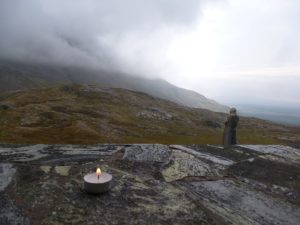
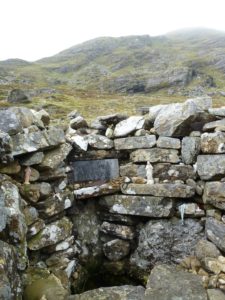
Another high holy well is a station on the St.Columcille or Columba pilgrimage route. We knew this was a pilgrimage for the deeply devout, but we were unprepared for the unbelievably gigantic cairn of large rocks that devotees have carried all the way up and placed there.
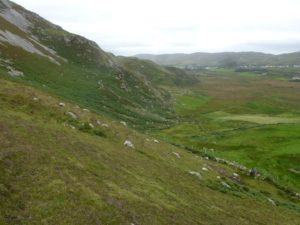
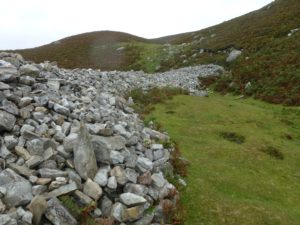
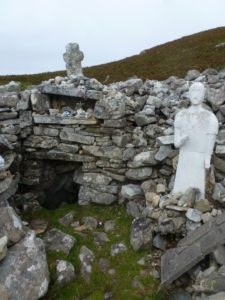
Some wells we have not been able to find, only to try again on another trip, like the well high in the limestone hills of the Burren, at Oughtmama, the Breast of the High Pass. Roman observers wrote that Druid sanctuaries often included both a sacred tree or grove and a water source. In Ireland a classic component of most holy wells is the presence of a tree, usually ash or hawthorn (a fairy tree). When we did finally get to the Oughtmama well and its windblown tree, with our Irish friend, Pius, who is equally enamored of holy wells, we made a small ceremony at which we sang a water blessing song and he recited a Gaelic poem in praise of Spirit.
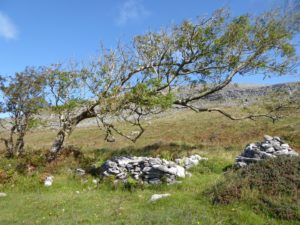
Returning from an effort made in service to soul, even if “unsuccessful,” feels fulfilling, once the sense of frustration passes, that is. All holy wells require some form of circumambulation, circling on foot, three times around sunwise, usually with ritual tasks to perform, a list of prayer sequences special to each well, at stations along the way. The body enjoys making these “rounds.” Some sites even provide a special path to make a mini-pilgrimage around the well. At the lovely holy well of Mary called Tobernault in Sligo there is a path up the hillside to a series of shrines and down around the wellspring and across the creek.
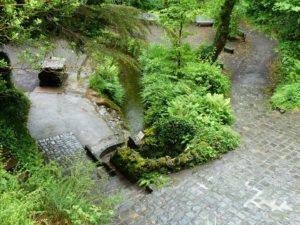
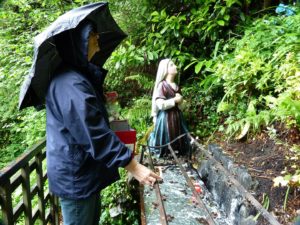
It is thought that veneration of wells began in pre-Christian times, but Celtic Christianity is so much closer to the land I don’t mind that many holy wells are named after Irish patron saints. Early Irish Christianity embraced folk and pagan practices. Most wells were dedicated to one of the innumerable local Irish saints. These men and women didn’t need to be martyred to become a saint. They did good for people, therefore were appreciated and venerated. But as Roman Christianity began to hold more sway some wells became re-dedicated to pan-Christian saints like Mary.
What causes a certain place to be deemed sacred? Since it’s hard to find any watery places here at home that us white folks collectively venerate as sacred, I always wonder about that. What makes water holy? Sometimes it’s as simple as this: a good person recognizes its goodness and blesses it. With Tony, our guide in the Burren, we made a pilgrimage up the rough limestone slabs to a lush, fern-filled grotto on the side of Slieve Carran. This is where in the 7th century St.Coleman had his hermitage. He lived in a tiny cell and made his bed in a small cave. Later, an early medieval limestone oratory was built there. At the crystal clear spring run beside his sanctuary Coleman was said to have made a simple well enclosure of stone with a rock slab on top. He deemed the water that entered profane and the water that emerged sacred.
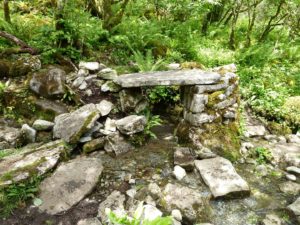
Because holy wells and sacred springs have been visited continuously by countless people passionately seeking to express devotion, they have absorbed love, and they exude love to subsequent seekers. Being repositories of love would be one of my definitions, if asked, of what makes a holy well sacred. The well of St. Brigid in her sanctuary at Kildare is one such love-permeated place.
The unique qualities, the power of the place itself where a well is located, might contribute to the well’s sanctity. At St.Brigid’s in Kildare, Cil Dara, ‘Church of the Oak,’ we spent a day with naturalist Michael Jacob learning about the ecology of bogs and fens of the Curragh grasslands and seeing its mythical/spiritual sites. The Curragh is perhaps the oldest and most extensive tract of natural grassland in Europe, having existed as such for over two thousand years. It was here that around 480AD the Abbess Brigid asked the King of Leinster for a bit of land on which to build her monastery. He said, sure, she could have as much as her cloak would cover. It billowed and spread over the whole great plain, which became known as Brigid’s Pasture. We picked rushes there to make a Brigid’s cross, the same place where they are picked for the festival of Imbolc.
After a wonderfully warm visit with Sister Mary at the new center called Solas Bhride, Brigid’s Flame, it felt auspicious to proceed on the traditional pilgrimage route to St. Brigid’s Cathedral, Wayside Well, and Round Well. The Wayside Well is known as the ancient pre-Christian sacred well of the Goddess Brigid. It is simple, rustic, its only decoration being an inscription in Irish that translates as “St. Brigid, Mary of the Gael, pray for us.” Its shallow, constantly bubbling spring waters are, I’m sure, a visionary place. This is the spring source of the waters of the Round Well. We continued on to the Round Well, circling it singing, We will never, never lose our way to the well of her memory. . . and, as is customary, scooped water into a bottle to take home for its strong healing properties. In exchange, we left the traditional strip of cloth tied to the nearby tree as an offering for its indwelling spirit.
In many cultures water is viewed as a feminine element, perhaps because it flows sensuously. At Solas Bhride the sisters are not interested in separating goddess Brigid from St.Brigid. They do express interest in what one sister called “the rising of the feminine.” One has only to scratch the surface to reveal Ireland’s grounding in the feminine. After all, Ireland, Eire, is named for the goddess Eriu, and women are strong, robust, and prominent in her mythology. Brigid is one of the three patron saints of Ireland along with Patrick and Colmcille or Columba. So, I was excited to hear that beginning Imbolc 2023 St.Brigid’s Day will be a national holiday! I wouldn’t mind for Ireland to take the lead in supporting the rising of the Divine Feminine and women in the world.
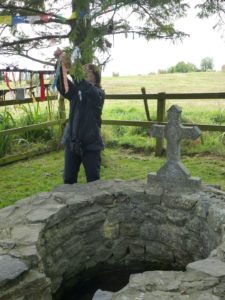
Another reason wells are venerated is that they have been sites of emotional healing or healing of certain parts of the body, so they are sought out to provide cures. In Ireland there are waters with specific healing properties to cure almost any ailment. I’ve dipped cloth strips into several “eye wells,” pressed the waters to my challenged eyes, then hung them on the “wishing trees,” adding them to the many other prayers for healing. I’d had digestion issues throughout one trip and was surprised when, near the end, we came upon a holy wetland dedicated to St. Patrick that was renowned for stomach cures. After walking a path through its cold waters I experienced relief, and soon after learned the cause of the distress.
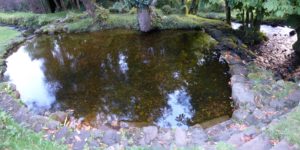
Or a spiritual practice has grown up over the years around certain waters. Pilgrimage is almost a national pastime in Ireland; there is even a national day of pilgrimage. Pilgrimage requires a destination. Water to which one could make a trek might be conducive to a well becoming revered as holy. Near Cahir, Tipperary, St. Berrihert was an 8th century hermit who lived alone with God and nature or else perhaps he had a monastery there. Louise Nugent of Pilgrimage in Medieval Ireland, who told us about this well, says St. Berrihert’s Kyle is likely a place of prehistoric pilgrimage. It’s notoriously hard to find.
Looking for holy wells has generated an amazing number of visits from what we have come to recognize as helpful fairies. This was a two-fairy well. Following directions, the tiny country roads kept getting smaller and smaller until we were winding around on narrow boreens, lost. Suddenly a man stepped out from behind vegetation and asked if we needed help. This was the farmer whose land the well is on, happening to arrive at just that moment on the way to check on his cows. He told us to turn at the next boreen. Now we knew there were no bulls there as reputed. Still, we managed to get lost again, but a lady fairy arrived from nowhere and kindly directed us to the correct farm gate. These seemed to be the only two folks in existence for miles.
We climbed over the stile, walked across a field, and then on wooden planks placed across a marsh. We were unprepared for what we came to. The kyle ‘burial ground’ is a strange and wonderful place. A circular stone wall incorporates a huge oak tree. Next to the tree a stone stile crosses over the wall. Once inside, we gazed in amazement at some 67 old stone cross slabs fixed on top of and incorporated into the wall. It is thought that some of these cross slabs might have been brought as votive offerings to a medieval church that used to be there. There is a low altar with the encircled heads of a large and a small high cross and a pre-Christian bullaun stone for curing or cursing, depending on which way it’s turned.

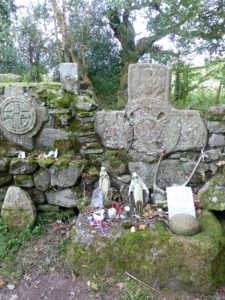
Entering an open gate we continued on another timber path through marsh, crossing a footbridge over a stream, until we came upon a very magical pool, formed of limestone springs, hidden in the forest. Standing alone in the silence, mesmerized, we watched the bubbles breaking the surface everywhere, making wide rings that gleamed in the green-glazed sunlight. They seemed like oracular messages rising from the below to the above, if one only knew how to interpret them. To me this gentle place evoked a feeling of happiness. There were all manner of offerings in gratitude in various places, including a little toy train riding on the wooden railing constructed to help one get down to the pool. We made offerings of quartz pebbles as welcomed by the spirits of many holy wells. White quartz is a healing stone beloved of faeries, and if there are such things as fairy pools, this seemed like one of them. Instructions for circumambulation of the well were, “Walk around three times, clockwise, whispering prayers. The prayer would sink deeper and deeper into the soul, and in the deepest ground an eager pilgrim will find the answers to his questions.”

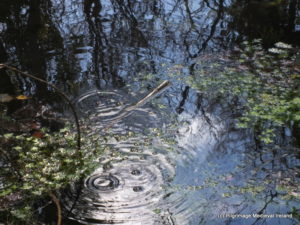
Another reason wells might have become recognized as sacred is that they are places where someone experienced something profound, maybe a miracle, so stories are remembered and told about them. Mythic stories such as of the wise salmon in the Well of Wisdom, located in the otherworld palace of the water god Mananan Mac Lir, live on in the Irish imagination. Some wells come with stories of a fish in the well, also an early symbol of Christianity, that appears when a cure is effected, such as at St. John’s Well in Kerry. A sign at the entrance to the path shows St. John’s Well, Tobar Eoin to be a fish well. This well is on a hillside overlooking the magnificent blue Dingle Bay with the Kerry Reeks, including the highest mountain in Ireland, visible just beyond. We sang to Oshun, the Yoruban goddess of sweet waters, as we danced around the well. At holy places ritual weaves the felt strands of connection between earth, spirit and us humans. With so many ways to attune ourselves and to honor earth and spirit, the choices of song or silence, dance or stillness seem to arise spontaneously out of a feeling for the soul, the energy, of each place.
We dipped a friend’s prayer tie in the water and tied it on the small tree, adding to an array of other symbolic offerings. When we pilgrimage to sacred wells my devotion tends to be reserved, conventional, properly tame, without my even realizing it. Home from Ireland, I realized I had pilgrimaged to, experienced blessing and being blessed by, the many holy wells we visited, all with a certain reserve. I went to Authentic Movement. Now I was on my knees at St John’s well washing, splashing, anointing all parts of me, giving my whole uninhibited self to the waters. Witnesses saw “a baptism” taking place. I made a drawing called “The Holy Well of the Heart.” It was the shape of St. John’s Well. As I was finishing the drawing a blue fish appeared in the center, in the heart of the well, magically, on its own. A cure for suppressed life-energies!
Wells might be regarded as sacred because visions have been received in such places. A certain holy well whose waters bubble slowly, hypnotically, up from the earth was one such portal of vision. As I stared deeply into it I was overcome by a trembling that took over my whole body. In the depths something awe-ful was glimpsed. Fear arose. I realized it was a vision of deep grief, my own and the world’s, if I let myself descend into I would drown. Back home, I definitely needed to revisit and dance out that experience. The drawing was titled Fear and Trembling, and making it helped me grieve deeply and safely. Dance as prayer and drawing as prayer have been potent spiritual containers for me, cauldrons of transformation. Adjuncts to pilgrimage.
Finally, a wellspring might be deemed holy because of the deep state of peace it induces. Tobar Iosa, the Well of Jesus, is such a place. The depth of the peace I experienced there opened me to a rare level of awareness such that I didn’t want to leave. I felt a desire to return there again and again to meditate. Perhaps I entered into that delicious calm because there was such a sense of wholeness. All the elements that make a satisfyingly complete holy well were there: An inviting gate, a path into an enclosed precinct, an altar, a bench to sit upon, the healing well, a path to circumambulate the well, and a prayer tree.
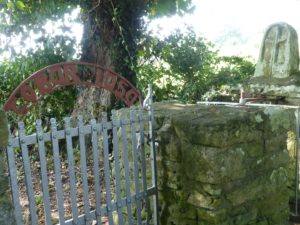
It’s said that this well probably dates from pre-Christian times. The lovely altar is made of a rounded sandstone slab that was supposed to have been used as a “mass rock,” a secret place where priests said mass during the penal times in the 18th century when Catholicism was outlawed. On the altar is an early medieval (7th or 8th century) upright slab upon which is carved two crosses.
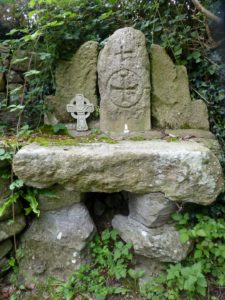
The wellspring is surrounded by a circular stone structure with steps leading down into the water. From there the water flows into a rectangular rock-enclosed shallow pool with a flat rock at which to kneel and bring one’s face to the water. A small stream flows from the spring well which joins a larger stream. We walked the path around it, crossing the stream on a rock, three times sunwise, singing softly. We tied a cloth strip on the tree for our daughter and prayed for the success of her new and somewhat dangerous venture. I felt a profound sense of peace.

A sign informed us that traditionally, to complete the ‘rounds’, three pebbles are taken from the well in remembrance of prayers made. It said that the local soldiers used to come to the well before being posted overseas and emigrants also prayed here before leaving Ireland, so, it continued, it is possible that there are now thousands of Tobar Iosa pebbles all over the world. It is the custom to return to the well when a prayer has been answered, when you’ve received the healing or blessing you prayed for, to tie a rag to the holy tree in thanks. Our prayers for our daughter were answered, so we went back to Tobar Iosa the following year and tied our cloth in gratitude.
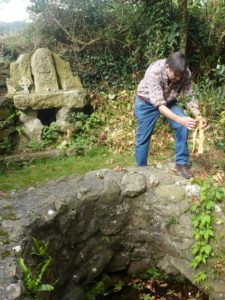
We all need to become more indigenous to our places on earth. The living waters somewhere near you are sacred if you feel them to be so and bless them as such. It’s really very simple:
— Prepare yourself to enter nature in a sacred manner.
Do something to open yourself spiritually, like burning incense to purify or setting an intention. Create a small pilgrimage.
— Open to the Presence and the Presences.
Do something to open to the spirit of the place, like creating a simple altar, lighting a candle, or making any small ritual of connection and communion, like singing a song.
— Express Love and Gratitude
Do something that expresses the relationship between your sacredness and the water’s sacredness, like making offerings, expressing praise, giving thanks. Clean it if it needs cleaning. Protect it if it needs protecting.
Text (c)2022 Betty Lou Chaika All photos, except St. Berrihert’s Well, (c)2022 Betty Lou and David Chaika
Shakti Rowan-Lena
Thank you! Halima forwarded your blog to me and I’m so grateful to connect with your writing and sharing of the sacred waters of Ireland. We spoke with you a few years back before going to Ireland and you recommended a few sacred places to visit.
I would love to be added to your mailing list!
With Gratitude, Shakti
Betty Lou Chaika
Shakti, yes, I remember speaking with you before your trip. I wonder if you have plans to go back when Covid gives us a break. I hope we can. I’ve added you to my mailing list, with pleasure. My best to Halima. Love, Hakima BL
Nancy Corson Carter
Dear Betty Lou,
I am charmed by the beauty and the relevance of your words and photos about holy wells and wetlands too. What a wonderful sharing! I felt as though in some sense I walked with you & David! 🙂
Would you mind if I quoted the first 2 paragraphs of it , attributing you & your whole work, for our weekly notes for The Church of Reconciliation?
Peace,
Betty Lou Chaika
Thanks so much, Nancy, for coming along with us and letting me know you enjoyed the trip! I must say that New Hope Creek feels pretty sacred to me. You are more than welcome to quote as much as you want. Your Earth Care work is so valuable.
Amanda Clarke
What a wonderful write up; so nice to read how the wells can be fully appreciated. I was impressed to see my local well, Lady’s Well on the Sheep’s Head – included. You might find my blog interesting.
Betty Lou Chaika
Amanda, thanks for your response. Yes, Finola of Roaringwater Journal first mentioned to us your work. When I want to look up a well in Cork/Kerry I check with you first! Oh, you are fortunate to live close enough to Lady’s Well to see it in August. The wonderful photo decorated with flowers and white cloth made my jaw drop. Not to mention it’s in that gorgeous setting.
Margot Ringenburg
How fortunate we both are to have been attracted to a place dotted with natural springs, from the bubbling pool near Mapleview, the source of Morgan Creek, to the seeps that breathe life into the lower slopes of Cane Creek Natural Area, where lush ferns grow and the eye & ear seek out the sight & sound of a gently flowing, wandering moss-lined stream. Yes, “water is life.” Thank you for both your mention of spring (!) and sharing yet another memory of your many pilgrimages across the sea to Ireland! How alluring I found the photo of St. Berrihert’s Kyle, along with the description of your adventure in reaching this truly liminal place.
Betty Lou Chaika
Thanks, Margot, for mentioning the pool at Mapleview and seeps at Cane Creek NA. Let me know of other springs you discover. I have lived in places where there was so much more water I’m afraid I lament a glass half empty here. When you get up to the Cavan Burren you must check out the Shannon Pot!
ann loomis
Such a beautiful piece of writing, Betty Lou. I’m reminded of my aunt and uncle’s well, which was surrounded by large stones. There was a hand pump that dipped into this stony well which my sister and I loved to play with. We thought it was a magical well. I’m also reminded of Carl Jung’s teaching that there’s a well within our psyches that we can “pump” for insights and solutions to a vexing problem. I’m delighted to hear that Imbolc will be declared a national holiday in Ireland next year. Yes, the feminine is rising!
Betty Lou Chaika
Thanks, Ann, for your story of the well of your childhood, and for your lovely reminder of children’s openness to the realm of magic. Yes, the endless wellspring within that taps into the Source flow. I guess the question is how can we each, in our own way, help the Feminine to rise and start to balance the out-of-control masculine.
Kathy Stardancer
A most wonderful writing about these sacred wells and the Divine Feminine. Loved the photos that accompanied your writing. Thanks for all you and David do to keep the Spirit of the Earth’s vibration aligned with ours.
Betty Lou Chaika
Hey Kathy, thanks for your kind words about the writing. And for the complement about the photos, especially appreciated coming from you, oh wonderful photographer! I’m grateful that we share resonance re the Divine Feminine. I had to smile at your ascribing to us the ability to keep the vibration of Earth aligned with the vibration of humans. If I had that power, that would be my greatest wish.
Karen Rossie
Thank you, Betty Lou, for this tour of the sacred wells. I enjoyed and resonated with your description of wells, springs, and wetlands as liminal places. I also loved your description of pilgrimmage: how the energy spent in a pilgrammage to visit sites like this is an embodied way of setting intention and a purifying preparation for arriving there. Lovely! I am inspired by your words to be more aware of the tiny spring that sometimes flows in my neighborhood.
Betty Lou Chaika
Karen, thanks for reading. You’re welcome for the tour of sacred water and wetlands. I can well imagine that it resonates with the intimacy you share with your creek. I’m glad we share an understanding of liminal space. There is so much to be explored there, whether in special wet places on the land or in the fluidity of the dream world.
Amina Karima McMakin
Dear one, Thanks so much for this beautiful article.I am inspired to pay more attention to the waters that surround our property. The Saluda River is one of our boundaries, and to get to our place we cross over a large pond. It has been declared a wetland (I think that’s the term), and I am now curious about its history. When we first moved here I dubbed the pond “turtle cove” because of the huge number of turtles that swam around in it and rested on various logs and rocks. The turtle is also one of my power animals, so I was delighted to have so many of them nearby. Thanks to you, I am reminded that we have a natural spring in nearby Williamston which is the theme of an annual festival–a perfect small pilgrimage!
Love and Blessings to you and Hamid for sharing your sacred journeys with us.💞💧🌊
Betty Lou Chaika
Dear Amina, I’m happy to hear you are inspired by the story to relate more to the waters of your land. I would be interested to hear what you find out about your wetland pond. Perhaps sometime soon we could do a blessing ceremony for your portion of the Saluda River and the wetland–and pilgrimage to the spring! You might be interested in reading about such blessing rituals in the next story.
Waterbird
An inspiring post with excellent advice to conclude.
Betty Lou Chaika
Waterbird, thank you for letting me know you enjoyed the story! By your name I’m guessing you have a very special relationship with waters and are yourself a tender of sacred water.